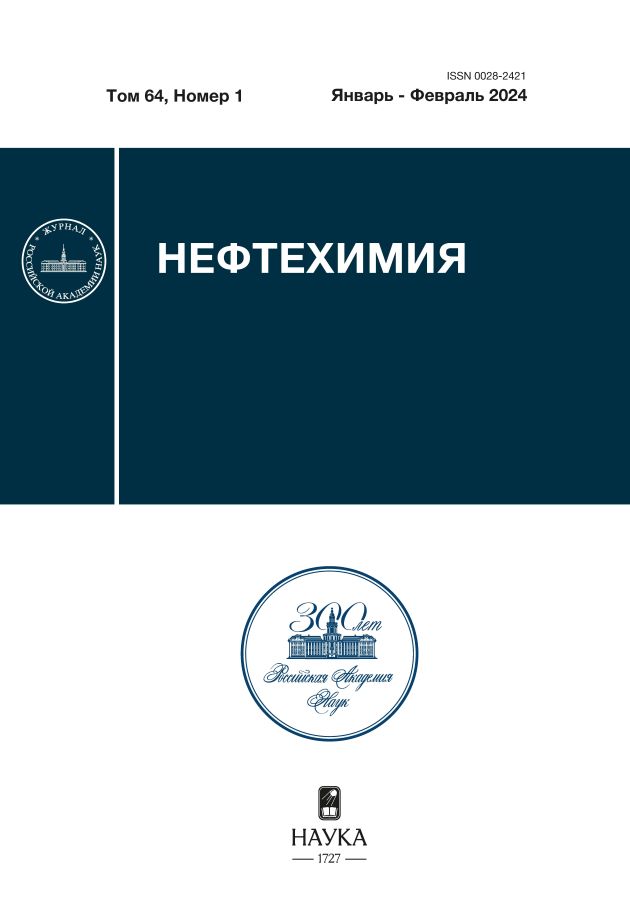Методология получения и анализа углеводородов алмазоподобного строения (от адамантанов до тетрамантанов) состава С10–С23 в нефтях
- Authors: Гордадзе Г.Н.1, Гируц М.В.1, Гаджиев Г.А.1
-
Affiliations:
- Российский государственный университет нефти и газа (национальный исследовательский университет) имени И. М. Губкина
- Issue: Vol 64, No 1 (2024)
- Pages: 42-54
- Section: Articles
- URL: https://jdigitaldiagnostics.com/0028-2421/article/view/655566
- DOI: https://doi.org/10.31857/S0028242124010036
- EDN: https://elibrary.ru/OJFTHT
- ID: 655566
Cite item
Abstract
В работе представлена методология получения и анализа углеводородов алмазоподобного строения (от адамантанов до тетрамантанов) состава С10–С23 из нефтей. Анализ включает в себя получение парафино-циклопарафиновой фракции из нефтей, концентрирование полициклических насыщенных углеводородов методом термодиффузионного разделения, каталитическую изомеризацию концентратов и последующий анализ как исходных фракций – протоадамантаноидов, так и продуктов изомеризации – адамантаноидов методом хромато-масс-спектрометрии. На примере нефтей различных месторождений продемонстрированы возможности предлагаемой методологии.
Full Text
About the authors
Гурам Николаевич Гордадзе
Российский государственный университет нефти и газа (национальный исследовательский университет) имени И. М. Губкина
Author for correspondence.
Email: gordadze@rambler.ru
ORCID iD: 0000-0002-5300-3059
д.г.-м.н., к.х.н., проф., академик РАЕН
Russian Federation, Москва, 119991Максим Владимирович Гируц
Российский государственный университет нефти и газа (национальный исследовательский университет) имени И. М. Губкина
Email: gordadze@rambler.ru
ORCID iD: 0000-0001-5057-6532
д.х.н., проф., академик РАЕН
Russian Federation, Москва, 119991Гаджи Ахмедович Гаджиев
Российский государственный университет нефти и газа (национальный исследовательский университет) имени И. М. Губкина
Email: gordadze@rambler.ru
ORCID iD: 0000-0002-8130-4801
к.х.н.
Russian Federation, Москва, 119991References
- Гордадзе Г.Н., Арефьев О.А. Адамантаны генетически различных нефтей. Углеводороды ряда адамантана // Нефтехимия. 1997. Т. 37. № 5. С. 387–395.
- Гордадзе Г.Н. Геохимия углеводородов каркасного строения (обзор) // Нефтехимия. 2008. Т. 48. № 4. С. 243–255.
- Гордадзе Г.Н., Русинова Г.В. Диамантаны состава С14–С15 в органическом веществе кристаллического фундамента // Геохимия. 2004. № 11. С. 1228–1232.
- Гордадзе Г.Н. Углеводороды в нефтяной геохимии (теория и практика). М.: РГУ нефти и газа имени И.М. Губкина, 2015. 559 с.
- Гируц М.В., Гордадзе Г.Н. Генерация адамантанов и диамантанов в результате термического крекинга полярных компонентов нефтей разного генотипа // Нефтехимия. 2007. Т. 47. № 1. С. 15–25.
- Бадмаев Ч.М., Гируц М.В., Эрдниева О.Г., Кошелев В.Н., Гордадзе Г.Н. Генерация моноалкиладамантов С11–С17 в результате катализа некоторых кислородосодержащих предшественников нефтяных углеводородов // Нефтехимия. 2011. Т. 51. № 5. С. 337–341.
- Гируц М.В. Русинова Г.В., Гордадзе Г.Н. Генерация адамантанов и диамантанов из высококипящих насыщенных фракций нефтей разного генотипа в присутствии кислотных катализаторов // Нефтехимия. 2005. Т. 45. № 3. С. 163–177.
- Dahl J.E.P., Wei Zh., Lipton P.A., Denisevich P., Gat R., Liu Sh., Schreiner P.R., Carlson R.M.K. Synthesis of higher diamondoids and implications for their formation in petroleum // Angewandte Chemie. 2010. V. 122. № 51. P. 10077–10081.
- Гируц М.В., Гордадзе Г.Н. Химия и геохимия углеводородов алмазоподобного строения. М.: Издательский дом Недра, 2017.
- Wei Z., Moldowan J.M., Dahl J. Formation of diamondoids from hydrous pyrolysis and their potential in modeling oil and gas generation. Stanford Molecular Organic Geochemistry Industrial Affiliates Internal Report, 2005.
- Гаджиев Г.А. Гируц М.В., Васильева А.В., Вылекжанина Д.С., Макарова М.Ю., Большакова М.А., Гордадзе Г.Н. Образование углеводородов ряда адамантана из современных и древних ископаемых смол (янтарей) хвойных деревьев // Химия твердого топлива. 2022. № 3. С. 61–67.
- Гордадзе Г.Н., Гируц М.В. Синтез углеводородов ряда адамантана и диамантана путем высокотемпературного крекинга высокомолекулярных н-алканов // Нефтехимия. 2008. Т. 48. № 6. С. 412–417.
- Гаджиев Г.А., Гируц М.В., Вылекжанина Д.С., Буров Е.А., Гордадзе Г.Н. К вопросу идентификации адамантанов С11–С13 в нефтях // Нефтехимия. 2021. Т. 61. № 5. С. 606–610.
- Нехаев А.И., Багрий Е.И., Максимов А.Л. Наноалмазы нефти: новое в области нафтенов алмазоподобного строения // Нефтехимия. 2011. Т. 51. № 2. С. 97–106.
- Wanka L., Iqbal K., Schreiner P.R. The lipophilic bullet hits the targets: medicinal chemistry of adamantane derivatives // Chem. Reviews. 2013. V. 113. № 5. P. 3516–3604.
- Fokin A.A. Merz A., Fokina N.A., Schwertfeger H., Shenggao L. Liu S.L., Dahl J.E.P., Carlson R.K.M., Schreiner P.R. Synthetic routes to aminotriamantanes, topological analogues of the neuroprotector Memantine® // Synthesis. 2009. V. 2009. № 06. P. 909–912.
- Schwertfeger H., Fokin A.A., Schreiner P.R. Diamonds are a chemist’s best friend: diamondoid chemistry beyond adamantane // Angewandte Chemie International Edition. 2008. V. 47. № 6. P. 1022–1036.
- Sinkel C., Agarwal S., Fokina, N.A., Schreiner P.R. Synthesis, characterization, and property evaluations of copolymers of diamantyl methacrylate with methyl methacrylate // Journal of Applied Polymer Science. 2009. V. 114. № 4. P. 2109–2115.
- Пилявский В.С., Хильчевский А.И., Петренко А.Е., Головко Л.В. Антифрикционные свойства адамантансодержащих сложных диэфиров // Катализ и нефтехимия. 2001. № 9–10. С. 103–106.
- Lin R., Wilk Z.A. Natural occurrence of tetramantane (C22H28), pentamantane (C26H32) and hexamantane (C30H36) in a deep petroleum reservoir // Fuel. 1995. V. 74. № 10. P. 1512–1521.
- Гируц М.В., Бадмаев Ч.М., Эрдниева О.Г., Стоколос О.А., Кошелев В.Н., Гордадзе Г.Н. Идентификация триамантанов в нефтях// Нефтехимия. 2012. Т. 52. № 2. С. 83–85.
- Петров Ал. А. Углеводороды нефти. М.: Наука, 1984. 264 с.
- Wingert W.S. GC–MS analysis of diamondoid hydrocarbons in Smackover petroleums // Fuel. 1992. V. 71. № 1. P. 37–43.
- Багрий Е.И. Адамантаны: получение, свойства, применение. М.: Наука, 1989. 264 с.
- Воробьева Н.С., Петров А.А. Высокомолекулярные адамантаноиды нефтей // Нефтехимия. 2001. Т. 41. № 5. С. 343–347.
- Гируц М.В., Дербетова Н.Б., Эрдниева О.Г., Стоколос О.А., Кошелев В.Н., Гордадзе Г.Н. Идентификация тетрамантанов в нефтях // Нефтехимия. 2013. Т. 53. № 5. С. 323–326.
Supplementary files






























